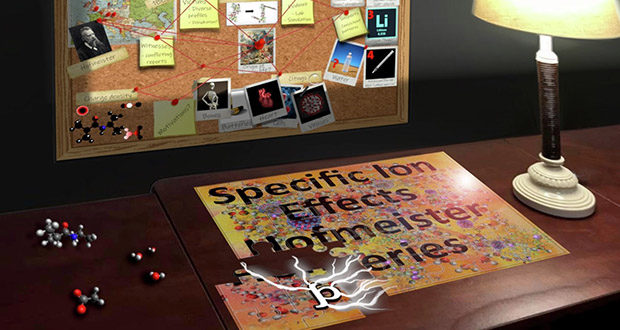Different salts, minerals and electrolytes all have different purposes. For instance, fluoride (a key ingredient in toothpaste) can increase the rate of virus reproduction in both human rhinovirus (usually responsible for the common cold) and HSV-1 (responsible for cold sores), whereas iodide (common in thyroid treatments) can decrease the rate of virus reproduction (this then links to viral load, and therefore severity of symptoms and transmissibility).
These trends are common in many biological, chemical, industrial, agricultural and geo-physical settings, yet have been historically difficult to predict, eluding scientists for over a century. By using quantum mechanics some fundamental properties at the atomic level have been found that quantify these effects.
Most of us use sugar and salt daily. Both readily dissolve in water, but how they behave when they do is very different. Sugar dissolves into uncharged identical sucrose molecules, whereas table salt dissolves into its constituent ions – sodium which is positively charged, and chloride which is negatively charged. There are thousands of other salts made up of combinations of hundreds of different ions.
It is a scientific challenge to capture, describe and predict how the addition of a certain salt will change the behaviour of a solution and give rise to these various applications. These “specific ion effects” are important in many industrial and technological processes, as well as being fundamental to understanding living systems.
Despite salty water covering about 70 per cent of our earth’s surface and aiding complex life formation billions of years ago, predicting electrolyte behaviour has been incredibly difficult. Some common trends in electrolyte behaviour were found by Franz Hofmeister and his student, Siegmund Lewith, 130 years ago, but the essence of what differentiates one ion’s behaviour from another’s still challenges scientists to this day.
Understanding the origins of these electrolyte behaviours that underpin our day to day lives allows for more control of ourselves and the surrounding environment, and will inherently save both time and money for many industrial processes and future research. It’s like knowing the rules for a game: to truly master the game, you need to know the rules, then be able to use them to your advantage.
We have now quantified this series for anions building a framework for predictions. Predictions that could expedite endeavours in multiple industries.
This is where new quantum chemical research comes into play. Quantum chemistry is done using supercomputers to safely model chemical systems. It allows us to see and calculate things that aren’t yet accessible via experiments. In this case, the aim was to: a) calculate the strength and “flavour” of ions interactions and, b) look at each atom within the ions separately and parameterise their strengths.
In part a) it appeared that electrostatics (the force that works when you rub a balloon against your jumper and then it sticks to the roof) seemed to be the key “flavour”. Part b) used Coulomb's equation from the 1780's that tells us opposite charges attract and that the closer they are, the greater the attraction. This allowed the derivation of a new parameter “sho”, ϸ, (which importantly allows for puns), that describes the essence of the anions.
Of course, up until here, it’s theoretical. So, time to ϸ off.
Applying this parameter to many different experiments appeared to capture the behaviour of these ions. A previously elusive task. This applied to systems as simple as salt dissolved in water, to systems involving complex biomolecules such as viruses, proteins and enzymes (how stable they were, or how fast they’d work).
But what are the implications for our daily lives?
Given the fundamental nature of this discovery, it should see benefits to fields and industries where ions are involved. Over 50 per cent of all pharmaceutical drugs exist as salts. The broad biological implications are also highly relevant to nutrition. Emerging smart surface and solution technology can have their function tuned by salt, broadening the scope of their applicability.
With the emergence of electric vehicles (EVs), the battery race is gaining speed (pun intended). These EVs are reliant on the battery (and/or capacitors, supercapacitors and fuel cell) technology to go the fastest, farthest and be the smallest, whilst charging quickly and repeatedly. Inherently, these are reliant on specific ion effects for optimising how much flowing charge you can pack in a small space. So, they’re important for “bettery” development if you will.
EVs are one of the combatants of climate change. Another combatant to global warming is the glaciers at the ice caps that reflect a large portion of the sun’s radiation. And guess what… their stability is also dependent on specific ion effects. As is the stability of soil that might determine its disposition to erosion.
Specific ion effects affect almost all aspects of our lives, and while this research didn’t quite finish the specific ion effects rulebook, it did find a very important rule – The Electrostatic Origins of Specific Ion Effects.
Kasimir Gregory is a PhD candidate in the School of Environmental and Life Sciences at The University of Newcastle.
Research funded by an Australian Government Research Training Program (RTP) Scholarship and Australian Research Council funding (ARC DP190100788, LE170100032 (INTERSECT)).
Do you have an idea for a story?Email [email protected]
 Campus Review The latest in higher education news
Campus Review The latest in higher education news


